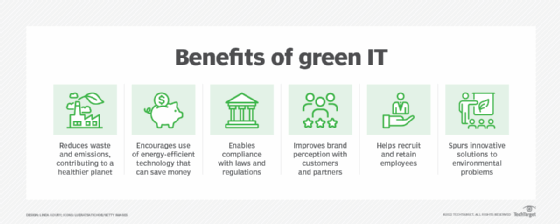
A green IT assessment: Why it's important, what to include
A company's technology systems and devices can have a profound effect on sustainability efforts. Learn how a green IT assessment can uncover areas that need improvement.
Before companies can improve the environmental impact of their technology systems and devices, they need to understand their current level of sustainability.
That's where a green IT assessment comes in. This type of assessment helps uncover energy hogs and negative environmental impacts, spotlighting areas for improvement.
The green IT assessment vs. the green IT audit
A green IT assessment evaluates a variety of IT sustainability factors. For example, it typically examines systems' and devices' power consumption since that's a major source of negative environmental impact. It could also verify that a given device is Energy Star certified to demonstrate energy efficiency. If a device has no noticeable green features, the item might need further review and could be a candidate for replacement.
Considering how many elements comprise an IT infrastructure -- from software to networks to data centers -- the list of items to assess for green activities can be lengthy. The data center can be a good place to start, as it houses many systems and technologies that impact the environment. Beyond the data center are hundreds and thousands of user-focused IT devices. Those devices include laptops, storage devices like hard disk drives, network devices like routers and security systems like firewalls.
A green IT assessment is typically a broader, less formal approach to evaluating the sustainability of enterprise technology, while an audit is far more formalized and generally denotes a comparison against a specific standard.
Assessments are often the precursor to audits. The assessment process is useful to identify potential audit findings to remediate before a formal audit. An assessment can identify problems with sustainability compliance, and list recommendations for improvement. This activity can be an effective way to reduce the number of potentially undesirable findings, making the formal green IT audit process a less difficult experience. That said, due to the less formalized nature of the assessment, some stakeholders might not take it seriously enough to pursue remedies to issues, which means that internal sustainability champions will need to advocate for change.

By contrast, with a green IT audit, auditors examine how organizations manage sustainability programs and policies, and whether technology systems uphold them.
In short, a green IT assessment can be a useful internal review to help understand the organization's current performance. A green IT audit formally evaluates a company's overall practices while offering recommendations to fine-tune the existing strategy.
Tech concerns in a green IT assessment
Companies prioritizing environmental sustainability can use a green IT assessment to evaluate the effectiveness of current practices. For example, the organization might have a sustainability initiative that includes an environmental, social and governance (ESG) framework to determine compliance. The ESG standards might then serve as additional assessment criteria. When preparing the technology part of the assessment, organizations should consider a range of areas to evaluate. These include the following:
- Energy consumption. Energy consumption is a key indicator in many ESG frameworks and is a primary green metric. IT teams should deploy energy-efficient devices wherever possible. Power supplies -- both inside and outside a data center -- should also be certified as energy efficient. Assessors can examine whether IT teams are shutting down devices when not in use and might advise putting the devices on timers to shut down at certain times or operating them during off-peak periods.
- Alternate energy sources. Assessors can evaluate the extent to which IT teams are using alternate energy sources, since those can help reduce energy costs and reduce the strain on natural resources. These alternate sources might include solar energy, hydroelectric energy and nuclear energy.
- Carbon emissions. Assessing carbon emissions is important because the smaller a carbon footprint is, the fewer greenhouse gases enter the atmosphere. For example, moving data center elements to a cloud environment might boost carbon conservation efforts, in cases where the vendor makes energy efficiency a priority.
- Waste management. Waste and e-waste can harm an organization's sustainability efforts, so this is an important area to examine. Companies that fall short in this area can work toward more sustainability by using an e-waste reduction program that returns equipment to service by refurbishing, reselling or responsibly disposing of end-of-life equipment.
- Server virtualization and cloud resources. Assessors can examine areas where virtualization and cloud use might support sustainability efforts. Server virtualization can simplify physical infrastructure, starting with consolidating multiple servers, to efficiently manage IT resources. Cloud providers -- such as AWS, Google Cloud and Microsoft Azure -- are investing in green data centers that can supplement on-premises arrangements.
- Building construction. The construction sector accounts for 37% of global greenhouse gases, according to the United Nations. That means assessors will want to scrutinize any building efforts in light of sustainability. For example, new data center buildings should be designed to be energy efficient and aim to achieve LEED (Leadership in Energy and Environmental Design) certification.
- Environment management. Assessors might recommend installing energy-efficient building environment systems, including HVAC, to help reduce energy consumption.
- Building lighting. The assessors might suggest installing low-energy consumption overhead lighting with timers or motion detectors to reduce unnecessary usage.
- Building windows and doors. Assessors might advise installing energy-efficient windows and doors with reflective glass to reduce the amount of heat entering the building.
Nontech issues to include in a green IT assessment
Green IT assessment issues might also cover nontechnical concerns. These issues might include policy, management or human behavior that could affect the company's long-term sustainability strategy. CIOs and IT leaders should consider including the following issues when performing an assessment:
- In-person vs. remote work. The COVID-19 pandemic spurred the use of remote working, which can reduce energy use simply because fewer employees are on-site. Many organizations are encouraging employees to return to in-person workdays, which might undo any green benefits.
- Employee morale. Companies can potentially increase employee satisfaction by demonstrating that the organization values sustainable practices.
- Policies supporting green initiatives. Organizations should strongly consider establishing corporate policies that stress energy conservation and use energy-efficient equipment. This step is crucial from an audit perspective, and its inclusion in an assessment can foster proactive issue resolution.
- Senior management support. Senior management needs to understand the importance of supporting environmental initiatives and ensure proper implementation. The success of such activities often relies on support from the C-suite.
- Standards compliance. While many green standards and regulations exist, ISO has two standards: ISO 50001:2018, which provides specifications for energy management systems and guidance for planning green IT initiatives, and ISO 50002:2014, which provides specifications for conducting energy audits.
- Reputation improvement. Embracing green initiatives can enhance a company's reputation and brand image among customers, investors and stakeholders.
IT leaders should consider performing a green IT assessment at a regular cadence. From there, they can use these assessments to make improvements. After making changes based on the audit, periodic refresher assessments can help determine if sustainable IT programs and resources are performing correctly.
Paul Kirvan is an independent consultant, IT auditor, technical writer, editor and educator. He has more than 25 years of experience in business continuity, disaster recovery, security, enterprise risk management, telecom and IT auditing.







